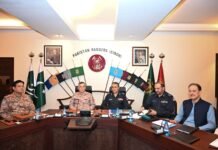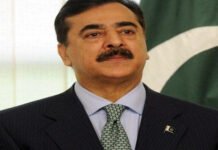By Shamim Akhtar
Another historic aerial battle of the Pakistan Air Force was the attack on Halwara, which represents a timeless story of the spirit of martyrdom, patriotism, courageous leadership, and professionalism of the team one that the Pakistani nation will always be proud of. After the 1965 war, February 27, 2019, was also a historic moment when the Shaheens of the Pakistan Air Force gave a befitting reply to the enemy and showed the world that Pakistan is always ready to defend its skies. The Shaheens not only shot down the Indian planes that violated the country’s airspace but also captured their pilot, Abhinandan. Today, the Falcons of the Pakistan Air Force, following in the footsteps of their predecessors, are armed with courage, faith, and the most advanced technology to defend the country.
The feats performed by the Falcons of the Pakistan Air Force alongside the ground forces during Operation Banyan Marsus are precious chapters in the history of air warfare. On the night of May 6 and 7, the Indian Air Force launched a large-scale attack, raising more than 70 of its jet fighters, including the Su-30, MiG-29, and 14 of the latest French-made Rafale aircraft in the cover of night. However, when confronted with the steely determination and defense of the Pakistani Falcons, the enemy was forced to retreat, suffering a severe blow and losing its nerve to proceed further. Resorting to missile and drone attacks from within Indian territory, the enemy targeted innocent civilians in Pakistan’s urban centers. Yet, the Falcons of the Pakistan Air Force—equipped with JF-17 Thunder, Mirage, and J-10C aircraft—stood resolute and responded decisively.
These air warriors, driven by a commitment to self-sacrifice, carefully targeted only those enemy aircraft posing a real threat to Pakistan. In this intense battle, Indian pride was crushed in locations like Anantnag, Pulwama, Panthial/Ramso, Ramban, Akhnoor, and Bathinda. The Pakistani Shaheens shot down six Indian aircraft, including three advanced Rafale fighters, a Russian-made Su-30, and a MiG-29. Thus, in one of the biggest air battles since World War II, more than a hundred modern aircraft from both countries engaged each other across long distances while remaining in their own airspace. It was a unique conflict where fighter pilots had to maneuver without direct visual contact, creating an environment of immense skill and precision.
In this battle, the Pakistan Air Force wrote a new chapter in air warfare by employing the latest electronic and cyber warfare technologies, effectively jamming enemy communications and radar systems. Global military analysts have since acknowledged the skill and determination of Pakistan’s pilots and the technological edge they demonstrated. The victory was not merely in the form of downing enemy aircraft; it was in the precise use of destructive weapons, the strategic jamming of enemy communication systems, and the pinpoint targeting of the adversary during battle.
Foreign media outlets have also praised Pakistan for this remarkable show of power and capability. A British newspaper went so far as to describe the Pakistan Air Force as the “ruler of the skies,” noting that Pakistani aircraft downed six Indian warplanes, including the expensive Rafale jets, with modern missiles. This performance established Pakistan’s clear air superiority, while India’s expensive investments failed to produce any meaningful success. Gulf media further reported that, for the first time in history, Rafale aircraft were destroyed in battle, and Pakistan’s air power emerged as a formidable challenge for India. As India’s billions of rupees worth of investments in its air force failed to make any difference, the world saw the Rafale’s defeat as a symbol of India’s humiliation.
Pakistan did not stop at shooting down the enemy’s aircraft. It destroyed several key Indian military installations, including airfields, BrahMos missile storage facilities, S-400 air defense systems, and more. According to a press conference by DG ISPR Lt. Gen. Ahmed Sharif Chaudhry, the Pakistan Air Force carried out successful strikes on Indian air bases at Adampur, Udhampur, Bathinda, Suratgarh, Mamoon, Akhnoor, Jammu, Sirsa, and Barnala, as well as the Indian Uri Field Supply Depot and the Halwara Airfield. The ISPR also confirmed that these were the bases used to target Pakistani civilians, mosques, and other important sites.
Pakistan’s JF-17 Thunder aircraft, armed with modern missile systems like the Chinese-made PL-15, further strengthened the country’s defense by targeting Indian hypersonic systems and military intelligence training centers in Rajouri, known to support terrorism in Pakistan. Air Vice Marshal Aurangzeb Ahmed emphasized that Pakistan has never compromised on the training standards of its armed forces. The successful use of the electromagnetic spectrum in this battle demonstrated the Pakistan Air Force’s exceptional professionalism and operational excellence.
The enemy’s aircraft lost all contact with their ground-based radar and control systems, while also losing communication with their supporting aircraft. The combination of electronic warfare, space-based technology, and cyber warfare created a new milestone in air combat history. Pakistan’s Falcons employed their expertise and the latest technology to bring down enemy aircraft with surgical precision, without suffering any losses of their own.
This defeat was a harsh blow for the Indian Air Force, whose highly touted Rafale jets and other modern aircraft became symbols of failure rather than strength. Today, Indian defense analysts and political leaders are struggling to explain away their humiliating defeat. Their media and so-called defense experts are now avoiding any public discussion of the incident, which has become a permanent scar on their military record.
The Pakistan Air Force, true to its traditions of courage and professionalism, once again demonstrated that it is ready to defend Pakistan’s sovereignty at any cost. Whether in 1965 or in the present day, the Falcons of the Pakistan Air Force have always answered the call of duty with bravery, professionalism, and an unshakable faith in victory. In this recent chapter, as in the past, they have shown the world that when the need arises, Pakistan’s air warriors will rise to the challenge, leaving behind a legacy of valor that will be remembered for generations to come.



